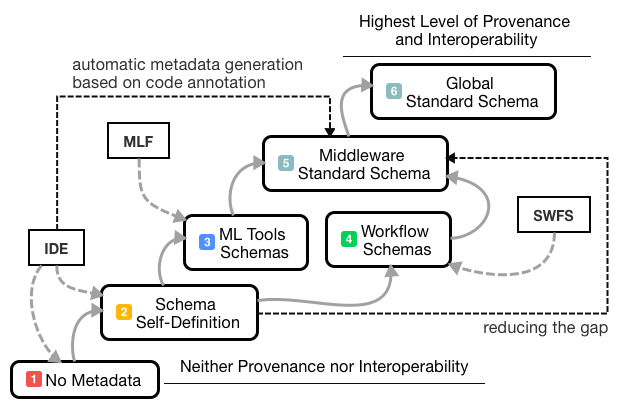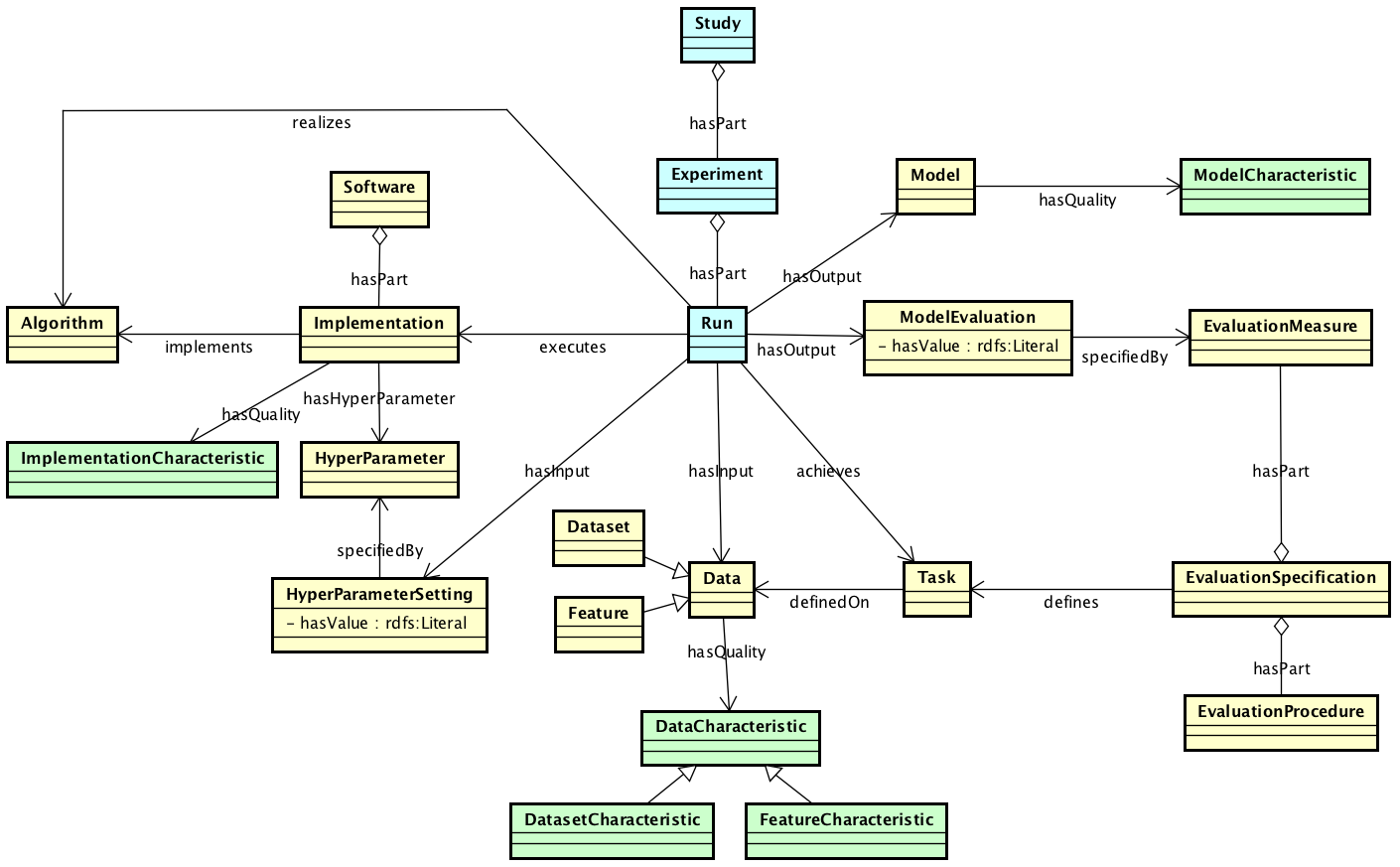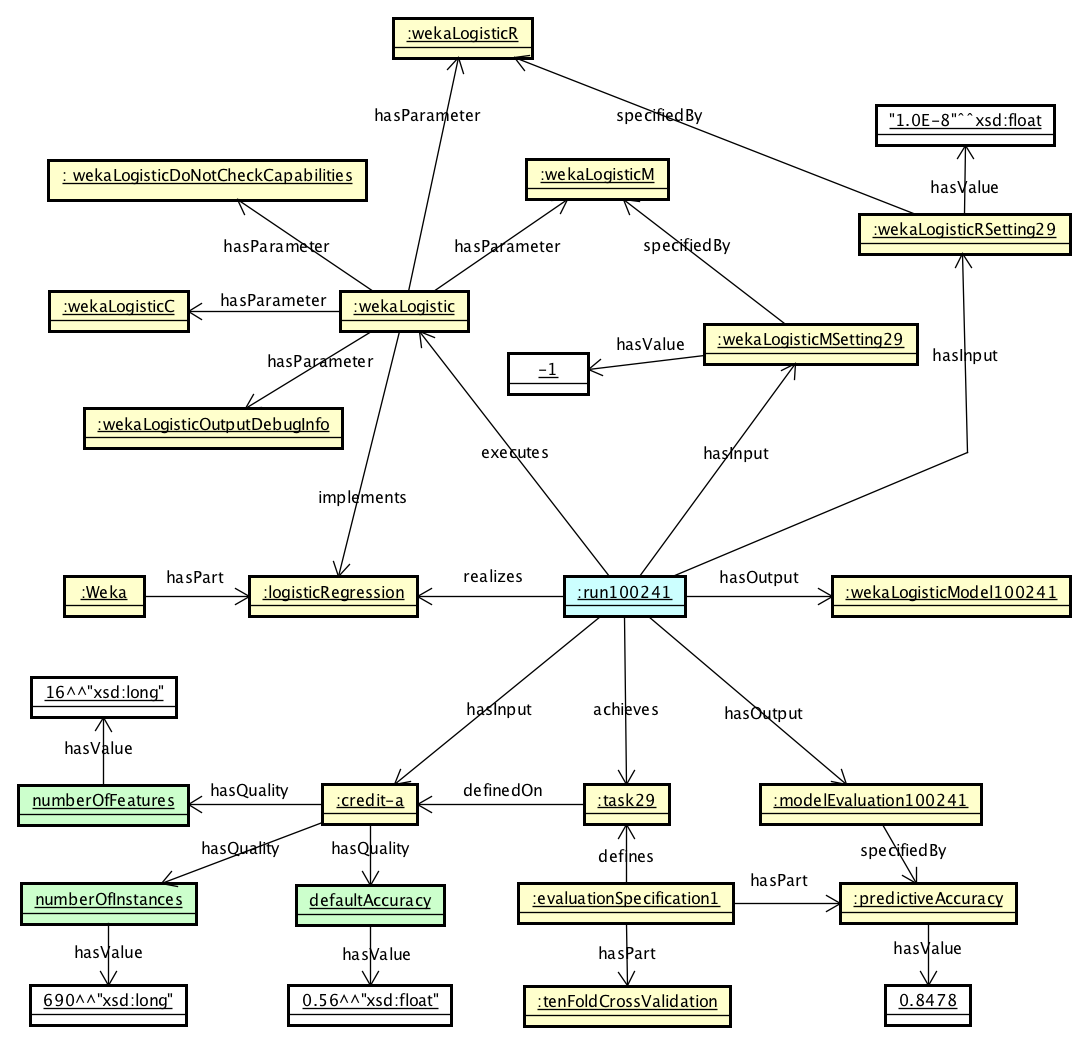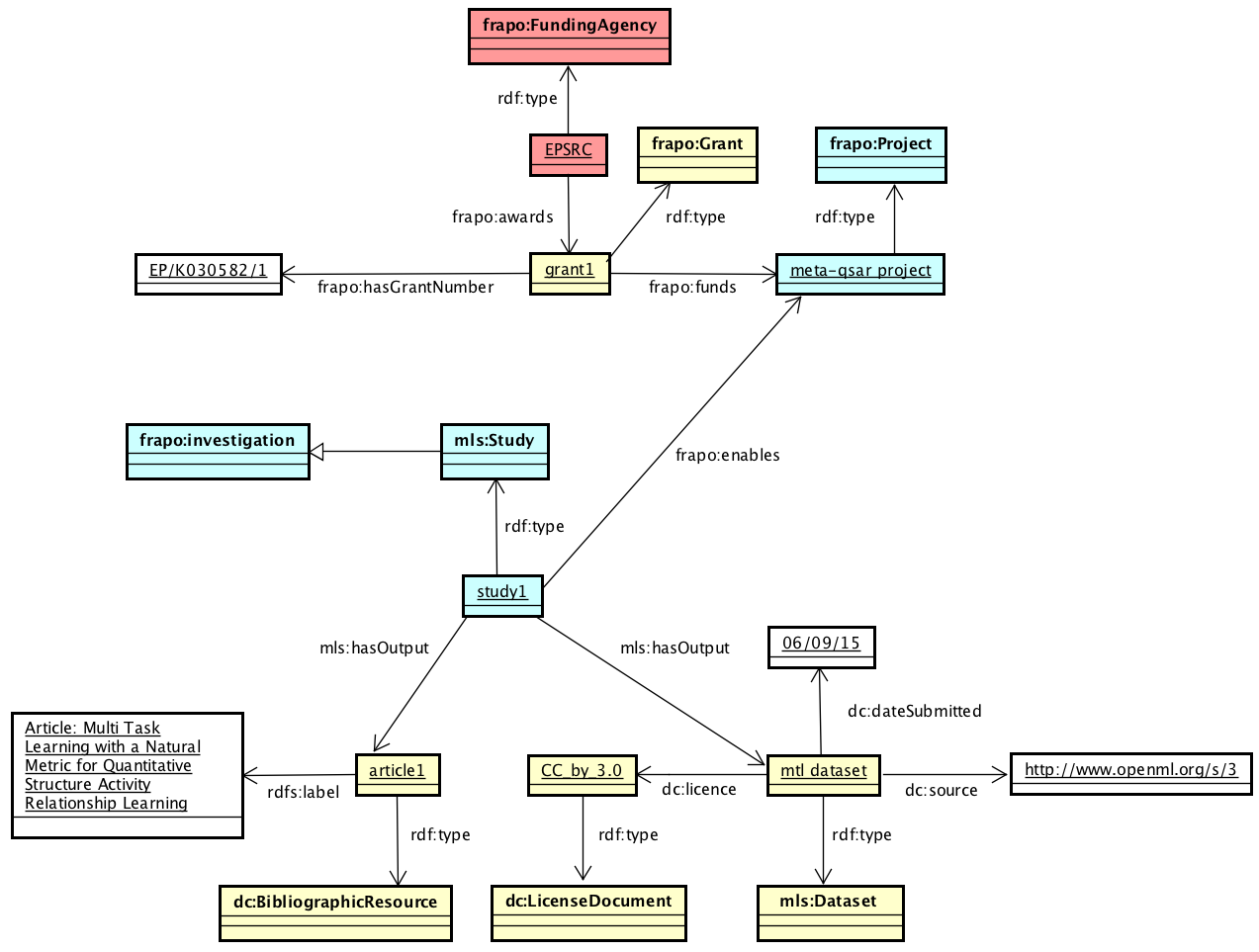
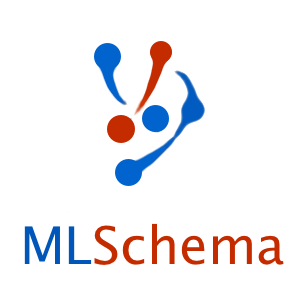
ML Schema Core Specification
Release 17 October 2016
- Latest version
- http://www.w3.org/2016/10/mls/
- Editors:
- Agnieszka Ławrynowicz, Poznan University of Technology
- Panče Panov, Jozef Stefan Institute
- Larisa Soldatova, Brunel University
- Tommaso Soru, University of Leipzig
- Joaquin Vanschoren, Eindhoven University of Technology
(alphabetic order)
- Authors:
- Diego Esteves, University of Leipzig
- Agnieszka Ławrynowicz, Poznan University of Technology
- Panče Panov, Jozef Stefan Institute
- Larisa Soldatova, Brunel University
- Tommaso Soru, University of Leipzig
- Joaquin Vanschoren, Eindhoven University of Technology
(alphabetic order)
Copyright © 2016 the Contributors to the ML Schema CG Specification, published by the W3C Machine Learning Schema Community Group under the W3C Community Contributor License Agreement (CLA). A human-readable summary is available.
Abstract
The ML Schema is a simple shared schema that provides a set of classes, properties, and restrictions that can be used to represent and interchange information on data mining and machine learning algorithms, datasets, and experiments.
It can be specialized to create new classes and properties. It can be mapped to more complex, specific ontologies on data mining and machine learning, and also used as a basis for markup languages and data exchange standards.
The namespace for ML Schema terms is http://www.w3.org/ns/mls#.
The OWL encoding of the ML Schema is available here.
Status of This Document
This specification was published by the Machine Learning Schema Community Group. It is not a W3C Standard nor is it on the W3C Standards Track. Please note that under the W3C Community Contributor License Agreement (CLA) there is a limited opt-out and other conditions apply. Learn more about W3C Community and Business Groups.
Table of Contents
1. Introduction
The core vocabulary of ML Schema deals with machine learning (ML) algorithms.
The schema can be used to represent the algorithms, the machine learning tasks they address, their implementations and executions, as well as inputs (e.g., data) and outputs (e.g., models) they specify.
This lightweight schema may be used as a basis for ontology development projects, markup languages and data exchange standards.
In particular, it aims to align existing machine learning ontologies and to support development of more specific ontologies with specific purposes/applications.
The main purpose is to increase interoperability by preventing a proliferation of incompatible machine learning ontologies as well as to provide a high-level standard to represent machine learning data. Thus, this scenario leads to a more representative and comprehensive ontology derived from existing state-of-the-art ML schemas.
The schema also defines a relationship between machine learning algorithms and their single executions and experiments and studies encompassing them.
It aims at stimulating the development of standards in order to achieve high level of interoperability among scientific experiments concerning machine learning.
By facilitating the metadata interchange process, the ML Schema may foster reproducible research.
Another goal of ML Schema related to interoperability and reproducible research it to facilitate turning machine learning algorithms and results into linked open data.
1.1 Benefits
Despite recent efforts to achieve a high level of interoperability of Machine Learning (ML) experiments we still run into problems created due to the existence of different ML platforms: each of those have a specific conceptualization or schema for representing data and metadata (Fig1: itens 3 and 4:
vertical interoperability). This scenario leads to an extra coding-effort (Fig1: item 2) to achieve both the desired interoperability and a better provenance level as well as a more automatized environment for obtaining the generated results.
To reduce the gap, ML vocabularies and ontologies have been proposed (Figure 1: item 5).
- Onto-DM has been designed to provide generic representations of principle entities in the area of data mining.
- DMOP has been developed with a purpose to support meta-mining, i.e. meta-learning from the full ML process.
- Expose is designed to describe (and reason about) machine learning experiments. It is built on top of OntoDM, and underlies OpenML, a collaboration and meta-learning platform for machine learning.
- MEX Vocabulary (mex-core, mex-algo and mex-perf) has been designed to tackle the problem of managing machine learning outcomes and sharing provenance information particularly on the basic machine learning iterations in a lightweight format.
The gap can be further significantly reduced by achieving interoperability among state-of-the-art (SOTA) schemata of those resources (Figure 1: item 5) i.e. achieving the
horizontal interoperability (Figure 1: item 6).
Therefore, different groups of researchers could exchange SOTA metadata files in a transparent manner, e.g.: from OntoDM and MEX (
MLSchema.Schema data = mlschema.convert('myfile.ttl', MLSchema.Ontology.OntoDM, MLSchema.Ontology.MEX)).
Besides a higher level of interoperability, it direct benefits ML Ecosystems (e.g.: OpenML) and ML Metadata Repositories (e.g.: WASOTA) which can rely on a more representative standard in their architecures.
In OpenML, MLSchema is used to export all machine learning datasets, tasks, workflows and runs as linked open data (in RDF). This allows scientists to connect the results of their machine learning experiments to other knowledge sources, or to build novel knowledge bases for machine learning research.
1.2 Notational Conventions
Throughout this document, we use
Turtle RDF Syntax to express examples showing the use of the schema.
2. The ML Schema description
The following diagram depicts the core ML Schema. Boxes represent classes of the schema.
Arrows without filled heads represent properties, arrows with empty heads represent subclass relations, and arrows with diamonds represent part-of relations.
- IRI:
- http://www.w3.org/ns/mls#
- Version IRI:
- http://www.w3.org/2016/10/mls#
- Other visualisation:
- Ontology source
We will illustrate the ML schema by means of two examples.
Firstly, we illustrate the ML schema with an example derived from the OpenML portal (see Fig. 3).
The example describes entities involved to model a single run of the implementation of a logistic regression algorithm from a Weka machine learning environment.
The referenced individuals can easily be looked up online.
For instance, run 100241 can be found on http://www.openml.org/r/100241.
Example 1
@prefix : <http://example.org#> .
@prefix mls: <http://www.w3.org/ns/mls#> .
@prefix owl: <http://www.w3.org/2002/07/owl#> .
@prefix rdf: <http://www.w3.org/1999/02/22-rdf-syntax-ns#> .
@prefix xsd: <http://www.w3.org/2001/XMLSchema#> .
:run100241 rdf:type owl:NamedIndividual ,
mls:Run ;
mls:executes :wekaLogistic ;
mls:hasInput :credit-a ,
:wekaLogisticMSetting29 ,
:wekaLogisticRSetting29 ;
mls:hasOutput :modelEvaluation100241 ,
:wekaLogisticModel100241 ;
mls:realizes :logisticRegression ;
mls:achieves :task29 .
:wekaLogistic rdf:type owl:NamedIndividual ,
mls:Implementation ;
mls:hasHyperParameter :wekaLogisticC ,
:wekaLogisticDoNotCheckCapabilities ,
:wekaLogisticM ,
:wekaLogisticOutputDebugInfo ,
:wekaLogisticR ;
mls:implements :logisticRegression .
:weka rdf:type mls:Software,
mls:hasPart :wekaLogistic.
:logisticRegression rdf:type owl:NamedIndividual ,
mls:Algorithm .
:wekaLogisticC rdf:type owl:NamedIndividual ,
mls:HyperParameter .
:wekaLogisticDoNotCheckCapabilities rdf:type owl:NamedIndividual ,
mls:HyperParameter .
:wekaLogisticM rdf:type owl:NamedIndividual ,
mls:HyperParameter .
:wekaLogisticOutputDebugInfo rdf:type owl:NamedIndividual ,
mls:HyperParameter .
:wekaLogisticR rdf:type owl:NamedIndividual ,
mls:HyperParameter .
:wekaLogisticMSetting29 rdf:type owl:NamedIndividual ,
mls:HyperParameterSetting ;
mls:specifiedBy :wekaLogisticM ;
mls:hasValue -1 .
:wekaLogisticRSetting29 rdf:type owl:NamedIndividual ,
mls:HyperParameterSetting ;
mls:specifiedBy :wekaLogisticR ;
mls:hasValue "1.0E-8"^^xsd:float .
:credit-a rdf:type owl:NamedIndividual ,
mls:Dataset ;
mls:hasQuality :defaultAccuracy ,
:numberOfFeatures ,
:numberOfInstances .
:defaultAccuracy rdf:type owl:NamedIndividual ,
mls:DatasetCharacteristic ;
mls:hasValue "0.56"^^xsd:float .
:numberOfFeatures rdf:type owl:NamedIndividual ,
mls:DatasetCharacteristic ;
mls:hasValue "16"^^xsd:long .
:numberOfInstances rdf:type owl:NamedIndividual ,
mls:DatasetCharacteristic ;
mls:hasValue "690"^^xsd:long .
:wekaLogisticModel100241 rdf:type owl:NamedIndividual ,
mls:Model .
:modelEvaluation100241 rdf:type owl:NamedIndividual ,
mls:ModelEvaluation ;
mls:specifiedBy :predictiveAccuracy ;
mls:hasValue 0.8478 .
:predictiveAccuracy rdf:type owl:NamedIndividual ,
mls:EvaluationMeasure .
:task29 rdf:type owl:NamedIndividual ,
mls:Task ;
mls:definedOn :credit-a .
:evaluationSpecification1 rdf:type owl:NamedIndividual ,
mls:EvaluationSpecification ;
mls:defines :task29 ;
mls:hasPart :TenFoldCrossValidation ,
:predictiveAccuracy .
:TenFoldCrossValidation rdf:type owl:NamedIndividual ,
mls:EvaluationProcedure .
In the example, the run :run100241 executes the implementation :wekaLogistic of the algorithm :logisticRegression which this execution realizes.
The run has on input the :credit-a dataset and its output is both the model :wekaLogisticModel100241 and the model evaluation :modelEvaluation100241.
The run achieves the task :task29.
The implementation :wekaLogistic implements the algorithm :logisticRegression.
The implementation has five hyperparameters: :wekaLogisticC, :wekaLogisticDoNotCheckCapabilities, :wekaLogisticM, :wekaLogisticOutputDebugInfo, :wekaLogisticR.
Two of these hyperparameters are set for the run :run100241.
The hyperparameter :wekaLogisticM has value set to -1 (expressed via the hyperparameter setting :wekaLogisticMSetting29), and the hyperparameter :wekaLogisticR that has its value set to "1.0E-8"^^xsd:float (expressed via the hyperparameter setting :wekaLogisticRSetting29).
The dataset :credit-a has several characteristics such as: :decisionStumpAUC, :defaultAccuracy, :numberOfInstances, :numberOfMissingValues.
The predictive model :wekaLogisticModel100241 is evaluated (:modelEvaluation100241) based on the specified evaluation measure :predictiveAccuracy.
The value of the evaluation measure modeled via the model evaluation :modelEvaluation100241 is 0.8478.
The task :task29 is defined on the dataset (credit-a) and on the evaluation specification :evaluationSpecification1.
The evaluation specification :evaluationSpecification1 has parts: the evaluation procedure :TenFoldCrossValidation and the evaluation measure:predictiveAccuracy.
Secondly, we illustrate ML schema with an example describing ML study (:study1) and the corresponding dataset :mtl_dataset, providing reference to a publication (:article1), and acknowledging the funding body (see Fig. 3) .
This example refers to the article “Multi-Task Learning with a Natural Metric for Quantitative Structure Activity Relationship Learning” by Sadawi et al which reports on the ML study carried out within the Meta-QSAR project (:meta-qsar_project) funded by :EPSRC (:grant1 with number EP/K030582/1).
The referred dataset is freely available in OpenML.
Exposing such metadata may be of use for possible collaborators who may wish to analyse research networks and try to assess the 'trustwothiness' of what is published in the literature.
Such information that a study is done within a funded project, may increase their level of trust to the published results.
Example 2
@prefix : <http://example.org#> .
@prefix mls: <http://www.w3.org/ns/mls#> .
@prefix owl: <http://www.w3.org/2002/07/owl#> .
@prefix rdf: <http://www.w3.org/1999/02/22-rdf-syntax-ns#> .
@prefix xsd: <http://www.w3.org/2001/XMLSchema#> .
@prefix dc: <http://purl.org/dc/elements/1.1/>> .
@prefix frapo: <http://purl.org/cerif/frapo/> .
@prefix foaf: <http://xmlns.com/foaf/0.1/> .
dc:BibliographicResource rdf:type owl:Class .
mls:Study rdfs:subClassOf frapo:Investigation .
:EPSRC rdf:type frapo:FundingAgency ,
owl:NamedIndividual ;
frapo:awards :grant1 .
:article1 rdf:type dc:BibliographicResource ,
owl:NamedIndividual ;
rdfs:label "Article: Multi Task Learning with a Natural Metric for Quantitative Structure Activity Relationship Learning" .
:grant1 rdf:type frapo:Grant ,
owl:NamedIndividual ;
frapo:hasGrantNumber "EP/K030582/1" ;
frapo:funds :meta-qsar_project .
:meta-qsar_project rdf:type owl:NamedIndividual ,
foaf:Project .
:mtl_dataset rdf:type owl:NamedIndividual ,
mls:Dataset ;
dc:licence :CC_by_3.0 ;
dc:dateSubmitted "06/09/15" ;
dc:source "http://www.openml.org/s/3" .
:CC_by_3.0 rdf:type owl:NamedIndividual ,
dc:LicenceDocument .
:study1 rdf:type owl:NamedIndividual ,
mls:Study ;
frapo:enables :meta-qsar_project ;
frapo:hasOutput :mtl_dataset .
Classes
Example 3
@prefix : <http://example.org#> .
@prefix mls: <http://www.w3.org/ns/mls#> .
@prefix owl: <http://www.w3.org/2002/07/owl#> .
@prefix rdf: <http://www.w3.org/1999/02/22-rdf-syntax-ns#> .
:logisticRegression rdf:type owl:NamedIndividual ,
mls:Algorithm .
IRI: http://www.w3.org/ns/mls#Dataset
- has super-classes
- datac
Example 4
@prefix : <http://example.org#> .
@prefix mls: <http://www.w3.org/ns/mls#> .
@prefix owl: <http://www.w3.org/2002/07/owl#> .
@prefix rdf: <http://www.w3.org/1999/02/22-rdf-syntax-ns#> .
:credit-a rdf:type owl:NamedIndividual ,
mls:Dataset ;
mls:hasQuality :decisionStumpAUC ,
:defaultAccuracy ,
:numberOfInstances ,
:numberOfMissingValues .
Example 5
@prefix : <http://example.org#> .
@prefix mls: <http://www.w3.org/ns/mls#> .
@prefix owl: <http://www.w3.org/2002/07/owl#> .
@prefix rdf: <http://www.w3.org/1999/02/22-rdf-syntax-ns#> .
:numberOfInstances rdf:type owl:NamedIndividual ,
mls:DatasetCharacteristic .
:numberOfMissingValues rdf:type owl:NamedIndividual ,
mls:DatasetCharacteristic .
:decisionStumpAUC rdf:type owl:NamedIndividual ,
mls:DatasetCharacteristic .
:defaultAccuracy rdf:type owl:NamedIndividual ,
mls:DatasetCharacteristic .
Example 6
@prefix : <http://example.org#> .
@prefix mls: <http://www.w3.org/ns/mls#> .
@prefix owl: <http://www.w3.org/2002/07/owl#> .
@prefix rdf: <http://www.w3.org/1999/02/22-rdf-syntax-ns#> .
:TenFoldCrossValidation rdf:type owl:NamedIndividual ,
mls:EvaluationProcedure .
Example 7
@prefix : <http://example.org#> .
@prefix mls: <http://www.w3.org/ns/mls#> .
@prefix owl: <http://www.w3.org/2002/07/owl#> .
@prefix rdf: <http://www.w3.org/1999/02/22-rdf-syntax-ns#> .
:evaluationSpecification1 rdf:type owl:NamedIndividual ,
mls:EvaluationSpecification ;
mls:defines :task29 ;
mls:hasPart :TenFoldCrossValidation ,
:predictiveAccuracy .
IRI: http://www.w3.org/ns/mls#Feature
- has super-classes
- datac
hyper parameterc back to ToC or Class ToC
IRI: http://www.w3.org/ns/mls#HyperParameter
- has super-classes
- information entityc
Example 8
@prefix : <http://example.org#> .
@prefix mls: <http://www.w3.org/ns/mls#> .
@prefix owl: <http://www.w3.org/2002/07/owl#> .
@prefix rdf: <http://www.w3.org/1999/02/22-rdf-syntax-ns#> .
:wekaLogisticC rdf:type owl:NamedIndividual ,
mls:HyperParameter .
:wekaLogisticDoNotCheckCapabilities rdf:type owl:NamedIndividual ,
mls:HyperParameter .
:wekaLogisticM rdf:type owl:NamedIndividual ,
mls:HyperParameter .
:wekaLogisticOutputDebugInfo rdf:type owl:NamedIndividual ,
mls:HyperParameter .
:wekaLogisticR rdf:type owl:NamedIndividual ,
mls:HyperParameter .
Example 9
@prefix : <http://example.org#> .
@prefix mls: <http://www.w3.org/ns/mls#> .
@prefix owl: <http://www.w3.org/2002/07/owl#> .
@prefix rdf: <http://www.w3.org/1999/02/22-rdf-syntax-ns#> .
@prefix xsd: <http://www.w3.org/2001/XMLSchema#> .
:wekaLogisticMSetting29 rdf:type owl:NamedIndividual ,
mls:HyperParameterSetting ;
mls:specifiedBy :wekaLogisticM ;
mls:hasValue -1 .
:wekaLogisticRSetting29 rdf:type owl:NamedIndividual ,
mls:HyperParameterSetting ;
mls:specifiedBy :wekaLogisticR ;
mls:hasValue "1.0E-8"^^xsd:float .
Example 10
@prefix : <http://example.org#> .
@prefix mls: <http://www.w3.org/ns/mls#> .
@prefix owl: <http://www.w3.org/2002/07/owl#> .
@prefix rdf: <http://www.w3.org/1999/02/22-rdf-syntax-ns#> .
:wekaLogistic rdf:type owl:NamedIndividual ,
mls:Implementation ;
mls:hasHyperParameter :wekaLogisticC ,
:wekaLogisticDoNotCheckCapabilities ,
:wekaLogisticM ,
:wekaLogisticOutputDebugInfo ,
:wekaLogisticR ;
mls:implements :logisticRegression .
Example 11
@prefix : <http://example.org#> .
@prefix mls: <http://www.w3.org/ns/mls#> .
@prefix owl: <http://www.w3.org/2002/07/owl#> .
@prefix rdf: <http://www.w3.org/1999/02/22-rdf-syntax-ns#> .
:wekaLogisticModel100241 rdf:type owl:NamedIndividual ,
mls:Model .
InformationEntityc
back to ToC or Class ToC
IRI: http://www.w3.org/ns/mls#InformationEntity
- has sub-classes
-
algorithmc,
datac,
evaluation measurec,
evaluation procedurec,
evaluation specificationc,
hyper parameterc,
hyper parameter settingc,
implementationc,
modelc,
model evaluationc,
softwarec,
task
model characteristicc back to ToC or Class ToC
IRI: http://www.w3.org/ns/mls#ModelCharacteristic
- has super-classes
- information entityc
Example 12
@prefix : <http://example.org#> .
@prefix mls: <http://www.w3.org/ns/mls#> .
@prefix owl: <http://www.w3.org/2002/07/owl#> .
@prefix rdf: <http://www.w3.org/1999/02/22-rdf-syntax-ns#> .
:modelEvaluation100241 rdf:type owl:NamedIndividual ,
mls:ModelEvaluation ;
mls:specifiedBy :predictiveAccuracy ;
mls:hasValue 0.8478 .
Example 13
@prefix : <http://example.org#> .
@prefix mls: <http://www.w3.org/ns/mls#> .
@prefix owl: <http://www.w3.org/2002/07/owl#> .
@prefix rdf: <http://www.w3.org/1999/02/22-rdf-syntax-ns#> .
:run100241 rdf:type owl:NamedIndividual ,
mls:Run
mls:executes :wekaLogistic ;
mls:hasInput :credit-a ,
:wekaLogisticMSetting29 ,
:wekaLogisticRSetting29 ;
mls:hasOutput :modelEvaluation100241 ,
:wekaLogisticModel100241 ;
mls:realizes :task29 .
IRI: http://www.w3.org/ns/mls#Software
- has super-classes
- information entityc
- hasPartop some implementationc
Example 14
@prefix : <http://example.org#> .
@prefix mls: <http://www.w3.org/ns/mls#> .
@prefix owl: <http://www.w3.org/2002/07/owl#> .
@prefix rdf: <http://www.w3.org/1999/02/22-rdf-syntax-ns#> .
:weka rdf:type mls:Software,
mls:hasPart :wekaLogistic.
IRI: http://www.w3.org/ns/mls#Task
- has super-classes
- information entityc
- definedOnop some datac
Example 15
@prefix : <http://example.org#> .
@prefix mls: <http://www.w3.org/ns/mls#> .
@prefix owl: <http://www.w3.org/2002/07/owl#> .
@prefix rdf: <http://www.w3.org/1999/02/22-rdf-syntax-ns#> .
:task29 rdf:type owl:NamedIndividual ,
mls:Task ;
mls:definedOn :credit-a .
Object Properties
IRI: http://www.w3.org/ns/mls#achieves
- has super-properties
-
top object property
IRI: http://www.w3.org/ns/mls#definedOn
- has super-properties
-
top object property
IRI: http://www.w3.org/ns/mls#defines
- has super-properties
-
top object property
IRI: http://www.w3.org/ns/mls#executes
- has super-properties
-
top object property
IRI: http://www.w3.org/ns/mls#hasHyperParameter
- has super-properties
-
top object property
IRI: http://www.w3.org/ns/mls#hasInput
- has super-properties
-
top object property
IRI: http://www.w3.org/ns/mls#hasOutput
- has super-properties
-
top object property
IRI: http://www.w3.org/ns/mls#hasPart
- has super-properties
-
top object property
IRI: http://www.w3.org/ns/mls#hasQuality
- has super-properties
-
top object property
IRI: http://www.w3.org/ns/mls#implements
- has super-properties
-
top object property
IRI: http://www.w3.org/ns/mls#realizes
- has super-properties
-
top object property
IRI: http://www.w3.org/ns/mls#specifiedBy
- has super-properties
-
top object property
Annotation Properties
IRI: http://purl.org/dc/terms/description
IRI: http://purl.org/dc/terms/hasVersion
IRI: http://purl.org/dc/terms/issued
IRI: http://purl.org/dc/terms/modified
IRI: http://www.w3.org/2004/02/skos/core#note
IRI: http://purl.org/dc/terms/publisher
IRI: http://purl.org/dc/terms/title

